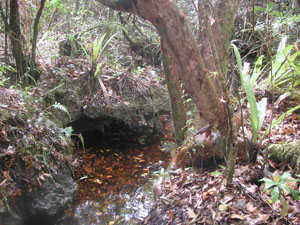
Hardwood hammocks are broad-leaved forests found on well-drained south Florida sites where fire has been infrequent in the recent past. In the Keys, where freezing temperatures are rarely if ever encountered, the hammock flora is exclusively of tropical origin, but moving north on the mainland, temperate species like live oak and hackberry become increasingly important. The diversity of native woody plant species in the hammocks is highest of all south Florida plant communities, and may be unparalleled in the continental US. The dry tropical forests, or “coppice”, found on the nearby Bahamian islands are probably their closest analogues.
South Florida hammock forests are most often rooted directly in outcropping limestone. In this setting, the soil mantle is a shallow layer of organic materials produced over generations by the trees themselves. In their most developed condition, these soils reach 20-30 cm in depth, and are classified as Histosols (Folists). In such shallow, calcium-rich soils, both moisture and phosphorus availability may limit forest productivity. However, not all south Florida hammocks are P-limited. Small tropical hammock s that form the heads of large tree islands in the interior Everglades are extremely high in phosphorus, with soil P averaging about 5% by weight. Multiple sources likely contribute to these astronomical P-concentrations, including roosting birds and groundwater pulled into the tree island through the transpiration stream.
s that form the heads of large tree islands in the interior Everglades are extremely high in phosphorus, with soil P averaging about 5% by weight. Multiple sources likely contribute to these astronomical P-concentrations, including roosting birds and groundwater pulled into the tree island through the transpiration stream.
A large majority of trees in southern Everglades and Keys hammocks produce fleshy fruits that ripen in late summer and fall. As such, a reciprocal dependency with resident and migratory animals is created: the trees are critical in the diet of the mammals and birds (as well as migratory avifauna), and the animals provide seed dispersal services for the trees. Rare and threatened animals dependent on the hardwood hammocks include the Key Largo woodrat and Key Largo cotton mouse, the white-crowned pigeon, and the Schaus’ swallowtail butterfly.